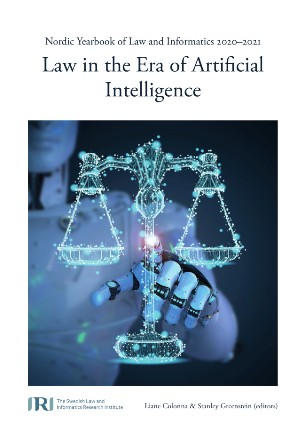| |
Pris: 420 SEK exkl. moms  |  Law in the Era of Artificial Intelligence includes a collection of papers presented at the 35th Nordic Conference on Law and Information Technology. The Conference was held in Stockholm in November 2020 and had the title ‘Law in the Era of Artificial Intelligence’. It examined the manner in which legal concepts, developed for a non-digital context, can continue to be applied in the era of artificial intelligence. The Law in the Era of Artificial Intelligence includes a collection of papers presented at the 35th Nordic Conference on Law and Information Technology. The Conference was held in Stockholm in November 2020 and had the title ‘Law in the Era of Artificial Intelligence’. It examined the manner in which legal concepts, developed for a non-digital context, can continue to be applied in the era of artificial intelligence. The
Nordic Yearbook of Law and Informatics 2020–2021 explores the above theme and is divided into four parts: data protection, transparency, liability and regulation.
The Nordic Yearbook of Law and Informatics (Nordisk årsbok i rättsinformatik) was initiated by the Scandinavian institutes for Law and Informatics. It was first published in 1984 and during the initial period a yearbook was produced on an annual basis. From its inception, hundreds of articles have been published, reflecting developments in the Scandinavian context and internationally.
The Swedish Law and Informatics Research Institute (IRI) is a research unit at the Faculty of Law, Stockholm University, and was founded in 1968. Having been instrumental in their establishment, IRI has had a long working relationship with The Swedish Society for IT and Law (Svenska föreningen för IT och juridik, SIJU) and The Foundation for Legal Information (Stiftelsen för rättsinformation), operating since 1988.
Table of Contents
Part 1: Data Protection
1. Legal Implications of Using AI as an Exam Invigilator – Liane Colonna 13
2. A Conceptual Approach to AI and Data Protection – Cecilia Magnusson Sjöberg 47
3. Complexity and Narrative Identity: A Shift from Design to Intention in Privacy Law – Sara Gandrén and Nicklas Berild Lundblad 63
Part 2: Transparency
4. Is There a Human Right to Human Contact? Preliminary Reflections on the Robotization of Caregiving – Katarina Fast Lappalainen 81
5. Explainable AI in the European Union: An Overview of the Current Legal Framework(s) – Martin Ebers 103
6. Algodicy: Justifying Algorithmic Suffering. Can Counter- factual Explanations be used for Individual Empowerment of those Subjected to Algorithmic Decision-Making (ADM)? – Katja de Vries 133
7. Transparency in Automated Algorithmic Decision-Making: Perspectives from the Fields of Intellectual Property and Trade Secret Law – Johan Axhamn 167
Part 3: Liability
8. Liability in the Era of Artificial Intelligence – Stanley Greenstein 185
9. Contractual Liability when “Things Do Not Go As Planned”: A Practical Perspective – Caroline Sundberg and Jessica Tressfeldt 207
10. Responsibility and Accountability: AI, Governance, and the Rule of Law – Richard Sannerholm 223
11. Between Risk Management and Proportionality: The Risk- Based Approach in the EU’s Artificial Intelligence Act Proposal – Tobias Mahler 247
Part 4: How to Regulate?
12. Can Artificial Intelligence be Regulated? Lessons from Legislative Techniques – Ubena John 273
13. Regulation of AI: Problems and Options – Håkan Hydén 295
14. Non-Asimov Explanations: Regulating AI Through Transparency – Chris Reed, Keri Grieman and Joseph Early 315
15. How to Regulate AI? – Peter Wahlgren 339
Contributors 351
| | |
|